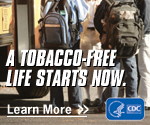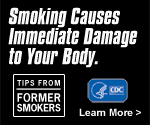Youth and Tobacco Use
Background
Smoking and smokeless tobacco use are initiated and established primarily during adolescence. More than 80% of adult smokers begin smoking before 18 years of age. Additionally, adolescent smokeless tobacco users are more likely than nonusers to become adult cigarette smokers.1,2,3
Youth cigarette use declined sharply during 1997–2003. Since that time, rates have declined far more slowly.4
Youth smokeless tobacco use also declined in the late 1990s and early 2000s, but an increasing number of U.S. high school students in some subgroups (such as white males) have reported using smokeless tobacco products in recent years.5
Current Estimates of Youth Tobacco Use
Cigarettes
Each day in the United States, approximately 3,800 young people under 18 years of age smoke their first cigarette, and an estimated 1,000 youth in that age group become daily cigarette smokers.6
Percentage of high school students who smoked one or more cigarettes in the previous month in 20097
- 19.5% of high school students
- 19.1% of female high school students
- 19.8% of male high school students
- 9.5% of black, non-Hispanic high school students
- 18.0% of Hispanic high school students
- 22.5% of white, non-Hispanic high school students
Percentage of middle school students who were current cigarette smokers in 20093
- 5.2% of middle school students
- 4.7% of female middle school students
- 5.6% of male middle school students
- 5.2% of black, non-Hispanic middle school students
- 2.5% of Asian, non-Hispanic middle school students
- 6.7% of Hispanic middle school students
- 4.3% of white, non-Hispanic middle school students
Cigars
Percentage of high school students who were current cigar smokers in 20097
- 14.0% of high school students
- 8.8% of female high school students
- 18.6% of male high school students
- 12.8% of black, non-Hispanic high school students
- 12.7% of Hispanic high school students
- 14.9% of white, non-Hispanic high school students
Percentage of middle school students who were current cigar smokers in 20093
- 3.9% of middle school students
- 3.2% of female middle school students
- 4.6% of male middle school students
- 4.7% of black, non-Hispanic middle school students
- 1.4% of Asian, non-Hispanic middle school students
- 6.2% of Hispanic middle school students
- 3.0% of white, non-Hispanic middle school students
Smokeless Tobacco
Percentage of high school students who were current smokeless tobacco users in 20097
- 8.9% of high school students
- 2.2% of female high school students
- 15.0% of male high school students
- 3.3% of black, non-Hispanic high school students
- 5.1% of Hispanic high school students
- 11.9% of white, non-Hispanic high school students
Percentage of middle school students who were current smokeless tobacco users in 2009:3
- 2.6% of middle school students
- 1.4% of female middle school students
- 3.7% of male middle school students
- 1.7% of black, non-Hispanic middle school students
- 1.7% of Asian, non-Hispanic middle school students
- 2.5% of Hispanic middle school students
- 2.5% of white, non-Hispanic middle school students
Factors Associated with Youth Tobacco Use
Some factors associated with youth tobacco use include the following1,8
- Low socioeconomic status
- Use and approval of tobacco use by peers or siblings
- Exposure to smoking in movies
- Lack of skills to resist influences to tobacco use
- Smoking by parents or guardians and/or lack of parental support or involvement
- Accessibility, availability, and price of tobacco products
- A perception that tobacco use is the norm
- Low levels of academic achievement
- Low self-image or self-esteem
- Exposure to tobacco advertising
- Aggressive behavior (e.g., fighting, carrying weapons)
Tobacco use during adolescence is associated with the following health risk behaviors:1,9
- High-risk sexual behavior
- Use of alcohol
- Use of other drugs
Reducing Youth Tobacco Use
National, state, and local program activities that have reduced and prevented youth tobacco use in the past have included combinations of the following:4,10
- Counteradvertising mass-media campaigns (i.e., TV and radio commercials, posters, and other media messages targeted toward youth to counter pro-tobacco marketing)
- Comprehensive school-based tobacco-use prevention policies and programs (e.g., tobacco-free campuses)
- Community interventions that reduce tobacco advertising, promotions, and commercial availability of tobacco products
- Higher costs for tobacco products through increased excise taxes
NOTES:
- High school student is defined as students in grades 9 through 12.
- Middle school student is defined as students in grades 6 through 8.
- Daily smoking is defined as ever smoking every day for at least 30 days.
- Current smoking and smokeless tobacco use are defined as using on 1 or more of the 30 days preceding the survey.
References
- U.S. Department of Health and Human Services. Preventing Tobacco Use Among Young People: A Report of the Surgeon General. Atlanta: U.S. Department of Health and Human Services, Centers for Disease Control and Prevention, Office on Smoking and Health, 1994 [accessed 2012 Feb 14].
- Campaign for Tobacco-Free Kids.
The Path to Smoking Addiction Starts at Very Young Ages
 (PDF–93 KB). Washington: Campaign for Tobacco-Free Kids, 2009 [accessed 2012 Feb 14].
(PDF–93 KB). Washington: Campaign for Tobacco-Free Kids, 2009 [accessed 2012 Feb 14]. - Centers for Disease Control and Prevention. Tobacco Use Among Middle and High School Students—United States, 2000–2009. Morbidity and Mortality Weekly Report 2010;59(33):1063–8 [accessed 2012 Feb 14].
- Centers for Disease Control and Prevention. Cigarette Use Among High School Students—United States, 1991–2009. Morbidity and Mortality Weekly Report 2010;59(26):797–801 [accessed 2012 Feb 14].
- Johnston LD, O'Malley PM, Bachman PM, Schulenberg JE.
Monitoring the Future—National Results on Adolescent Drug Use: Overview of Key Findings, 2010
 (PDF–1.30 MB). Ann Arbor (MI): University of Michigan, Institute for Social Research, 2011 [accessed 2012 Feb 14].
(PDF–1.30 MB). Ann Arbor (MI): University of Michigan, Institute for Social Research, 2011 [accessed 2012 Feb 14]. - Substance Abuse and Mental Health Services Administration.
Results from the 2010 National Survey on Drug Use and Health: Summary of National Findings

(PDF–2.56 MB). [accessed 2012 Feb 14]. - Centers for Disease Control and Prevention. Youth Risk Behavior Surveillance—United States, 2009 (PDF–3.51 MB). Morbidity and Mortality Weekly Report 2010;59(SS-5) [accessed 2012 Feb 14].
- U.S. Department of Health and Human Services. Reducing Tobacco Use: A Report of the Surgeon General. Atlanta: U.S. Department of Health and Human Services, Centers for Disease Control and Prevention, National Center for Chronic Disease Prevention and Health Promotion, Office on Smoking and Health, 2000 [accessed 2012 Feb 14].
- Campaign for Tobacco-Free Kids.
How Parents Can Protect Their Kids from Becoming Addicted Smokers
 (PDF–198.96 KB). Washington: Campaign for Tobacco-Free Kids, 2009 [accessed 2012 Feb 14].
(PDF–198.96 KB). Washington: Campaign for Tobacco-Free Kids, 2009 [accessed 2012 Feb 14]. - Centers for Disease Control and Prevention. Best Practices for Comprehensive Tobacco Control Programs—2007. Atlanta: U.S. Department of Health and Human Services, Centers for Disease Control and Prevention, National Center for Chronic Disease Prevention and Health Promotion, Office on Smoking and Health, 2007 [accessed 2012 Feb 14].
For Further Information
Centers for Disease Control and Prevention
National Center for Chronic Disease Prevention and Health Promotion
Office on Smoking and Health
E-mail: tobaccoinfo@cdc.gov
Phone: 1-800-CDC-INFO
Media Inquiries: Contact CDC's Office on Smoking and Health press line at 770-488-5493.
File Formats: All viewers, players, and plug-ins used on this site can be downloaded from the file formats page. (For example: Adobe Acrobat Reader for pdf files, Windows Media Player for audio and video files, PowerPoint Viewer for presentation slides, etc.)
Contact Us:
- CDC/Office on Smoking and Health
4770 Buford Highway
MS K-50
Atlanta, Georgia 30341-3717 - 800-CDC-INFO
(800-232-4636)
TTY: (888) 232-6348
8am–8pm ET
Monday–Friday
Closed Holidays - tobaccoinfo@cdc.gov





